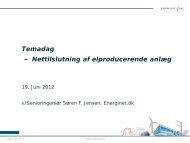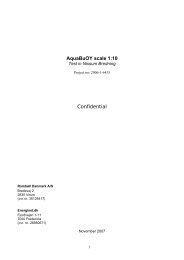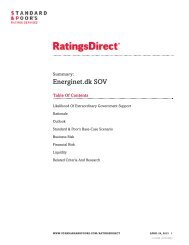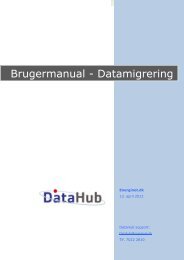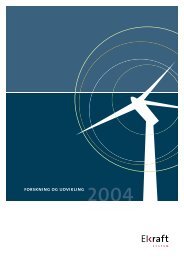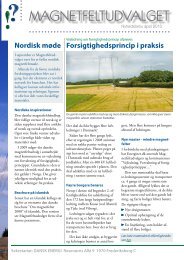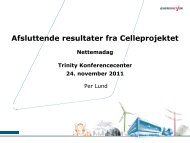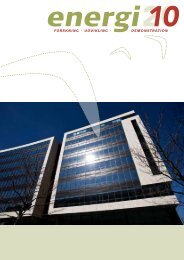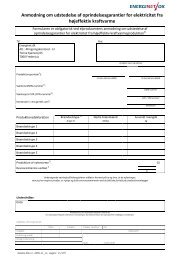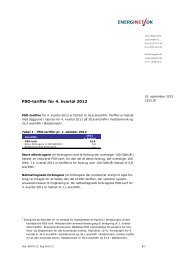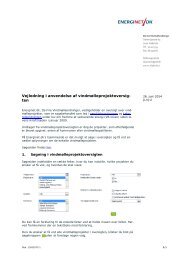smart griD IN DENmARK 2.0 - Energinet.dk
smart griD IN DENmARK 2.0 - Energinet.dk
smart griD IN DENmARK 2.0 - Energinet.dk
- No tags were found...
You also want an ePaper? Increase the reach of your titles
YUMPU automatically turns print PDFs into web optimized ePapers that Google loves.
<strong>smart</strong> grid <strong>IN</strong> DENMARK <strong>2.0</strong> | 21CONCEPT MATCHES FUTURE DISTRIBUTION OF ROLES <strong>IN</strong> THE ELECTRICITY MARKET¼ The concept matches the recently adopted act which determines the future distribution of roles in theelectricity market*). It is not required that the grid companies have direct commercial relations with thecustomers offering flexibility as commercial players will act as intermediaries.*) Act no. 575 of 18 June 2012 (promoting competition in the electricity market etc.)¼ Internationally, the concept is in line with legislation on liberalising the electricity market, including theseparation of grid companies and electricity suppliers. Via freely competing commercial players, bothgrid companies and <strong>Energinet</strong>.<strong>dk</strong> are able to benefit from flexible electricity consumption and production.For de kommercielle aktører giver det nye forretningsmuligheder.TO GRID Nye og RE<strong>IN</strong>FORCEMENTSeksisterende markedsaktører kanCONCEPT OFFERS GRID COMPANIES A REAL ALTERNATIVE¼ Price signals can be used as an incentive for customersskabetomerværdiplan their electricityved at samleconsumptionfleksibelt elforbrugorogproduction to suit the needs of the power system. However, -produktion it means fra mindre that their kunder response og DER cannot og melde be detguaranteed in advance, which in certain situations is aktivt unfortunate. ind i markederne.¼ Through trading flexibility products, it is, however, possible to enter into fixed agreements that a specificservice is supplied when – via the commercial players – it is activated by either a grid company or<strong>Energinet</strong>.<strong>dk</strong>. The quality of the service is ensured in that the players bringing flexibility to the marketmust be accredited in order to be active in the market place.¼ The market place is thus a supplementary measure, which means that the grid companies in particularcan be sure that their need for flexibility can be met at all times, and that they can thus useflexibility products as a real alternative to grid reinforcements.THE CONCEPT ENSURES FLEXIBILITY IS USED WHERE IT OFFERS MOST VALUE¼ The concept is an extension of the existing market design, where <strong>Energinet</strong>.<strong>dk</strong> – via internationalmarkets for regulating power and reserves – already meets its needs for flexibility in order to maintainsystem balance. The concept means that the flexibility from customers and DER can be offered tothese markets and thus increase what is on offer. At the same time, a new market is establishedwhere the grid companies can trade in flexibility. Coupling the new market to the existing marketsensures that the flexibility is used where it offers most value.THE CONCEPT OPENS UP THE POSSIBILITY OF ESTABLISH<strong>IN</strong>G NEW PLAYERS<strong>IN</strong> THE ELECTRICITY MARKET THAT CREATE ADDITIONAL VALUE¼ Electricity customers and DER are able to supply flexibility to the power system by responding to pricesignals. However, to be able to supply formal flexibility products, it is expected that a new role will beneeded in the electricity market which can combine flexible electricity consumption and productionfrom smaller customers and DER and actively offer it to the market.¼ These aggregators will operate in open competition with each other and can create added value byoffering the most innovative and effective solutions.



